Hole in the Clouds
Dec 10, 2009

Two girls who have recently immigrated to the United States, one from China and the other from Pakistan, have learned enough English and reading in Michele Manno's sixth-grade class to enjoy storybooks. Ms. Manno observes that both girls are good kids, eager to learn and interested in school, but one of them studies hard and the other "wants it spoon fed." They live and attend school in Queens, New York.
Queens
Pakistan
New York
sixth grade
Michele Manno
middle school
China
(Image credit: Michele Manno)
Sep 8, 2009
In the summer of 1913, Hazel Reiber winds up for a pitch near the ocean in the big sandlot at Long Beach, Long Island. Her bathing costume looks skimpier than the outfits many women wore back then, but her boots would do just fine for a professional wrestler.
That is a baseball in her right hand, but I'm guessing--hoping--that the person she's throwing to is not swinging a bat. It doesn't look safe for slugging thereabouts.
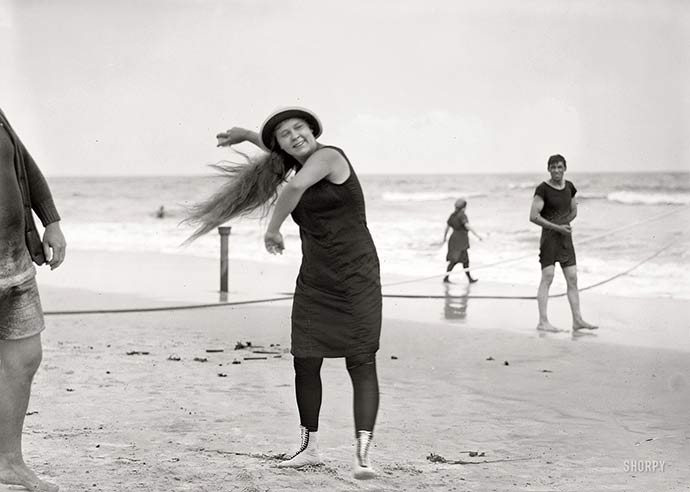
sports
New York
vintage
Long Island
beach
baseball
Hazel Reiber
(Image credit: Bain News Service, shorpy.com)
Sep 10, 2009
This picture must be ten or twelve years old now; Amelia Stein has grown up, finished high school and a year of college, and set out to begin her interior design studies at Parsons School of Art in New York City.
Once upon a time, the cost of living in some of the lower Manhattan neighborhoods not far from Parsons was so low that newly arrived immigrants moved into tenements there, straight off the boat. More recently, starving art students could still find affordable garrets in the vicinity. But nowadays, New York City is a tough place for students; Amelia was lucky enough to find a two-bedroom apartment to share . . . with five other girls. So far, she's loving it.

New York
kids
Amelia Stein
cousin
(Image credit: Norman Stein)
Sep 11, 2009
The Great Lakes are basically big puddles that filled with meltwater after the last Ice Age; to this day, almost all the rivers that feed the lakes come in from the north, where the glaciers used to be.
We could think of the Great Lakes as five bowls set on a staircase, each bowl brimming over and cascading down into the next. By the time the water slops over from the fourth bowl--Lake Erie--down to the last one--Lake Ontario--it's really spilling seriously, all fast and furious. And so we have Niagara Falls: an entire Ice Age of fossil water, draining down through four Great Lakes and then crashing hard through a narrow little riverbed to splash into that one last lake and then the St. Lawrence River and finally the Atlantic Ocean.
When European explorers first glimpsed Niagara, its connection to the two huge lakes seemed obvious and dramatic. This 1837 bird's eye view puts Lake Erie at the top, the falls in the middle, and Lake Ontario at the bottom of the picture, collecting all that splashover from ten thousand years of melting ice.

New York
Niagara Falls
Lake Ontario
Lake Erie
ice age
Canada
(Image credit: W.R. Callington)
Aug 20, 2009
Thirty-seven feet above the main entrance to 30 Rock in Manhattan, which used to be called the RCA building, this guy with a crown and a big beard pushes aside the dark clouds of ignorance to let the sunshine in. His big golden compass promises architecture and all the arts--castles and cathedrals of human achievement. The quotation is biblical, from the book of Isaiah, but the man with the compass is from some other spiritual realm, where civilization included commerce between godlike humans and all-too-human gods.
Who is he? Where did he come from? The short answer is that he was copied from an eighteenth-century painting by William Blake, "The Ancient of Days." Blake presents this Ancient as a false little god, trying to build his own false little world with that big compass. The compass also brings Masonic mysticism into the picture.
What was Rockefeller thinking in 1933, when he adorned the entrance to his crowning public achievement with this strange image? Elsewhere in his new Center, he memorialized Prometheus, who defied the gods by supplying humanity with the fire of science and art, and he commissioned a bronze Atlas, the demigod who carried the world on his back as punishment for warring against the real gods.
Ignorant and learned people both have tussled with this stuff, so I'll stay out of it. I just like the imagery of somebody pushing those clouds apart, making a hole, piercing the gloom with brave new light.

New York
Rockefeller Center
Manhattan
Freemasonry
William Blake
John D. Rockefeller
(Image credit: Ellen Stein)
Sep 22, 2009
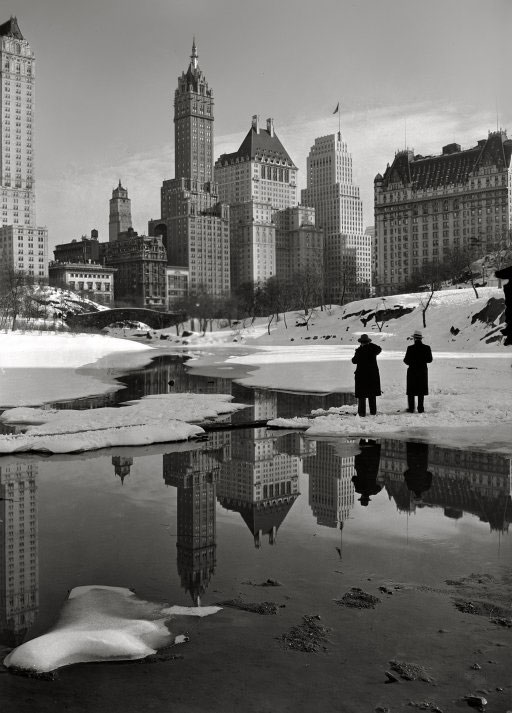
I'm not a New York person, but this view of the Savoy Plaza and other Midtown towers has got to be one of the most gorgeous cityscapes anywhere, ever. It was shot in Central Park in 1933 by architectural photographer Samuel Gottscho. Today, the view from the same spot would be dominated by tall glass office boxes; the Savoy and many of the other old towers have been demolished.
Gottscho worked as a traveling lace and fabric salesman for 23 years before he could work with his camera full time. He specialized in pictures of houses and gardens, but also branched out into nature photography.
A new novel by E.L. Doctorow uses a heavily photoshopped version of this picture on the cover.
New York
landscape
Manhattan
cityscape
Savoy Plaza
Central Park
(Image credit: Samuel H. Gottscho)
Aug 16, 2009
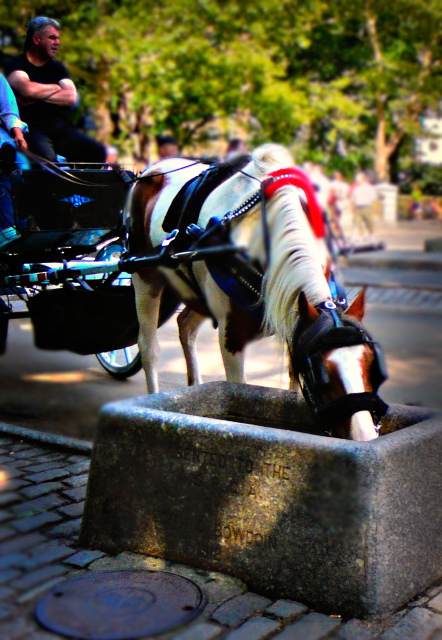
Even in the leafy dapple of New York's Central Park, these are dog days for horses.. The inscription on the trough reads: "Presented to the S.P.C.A. by Edith D. Bowdoin, 1912."
New York
animal
Central Park
Edith D. Bowdoin
horse
(Image credit: Ellen Stein)
Aug 12, 2009
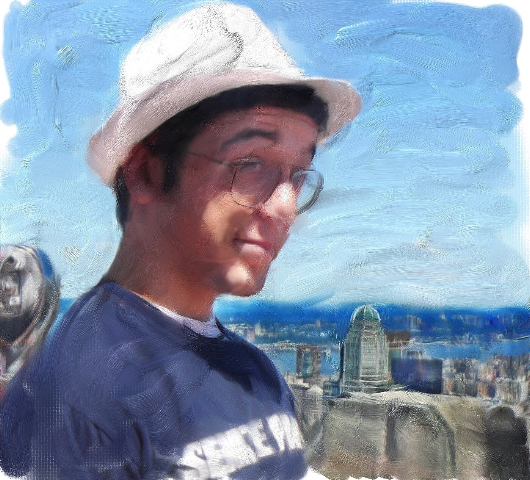
Hank is on the observation deck atop Rockefeller Center, and I've got a new software painting thing to play with.
New York
Hank Stein
Rockefeller Center
(Image credit: Ellen Stein)
Aug 9, 2009

Midtown Manhattan, looking south from the 68th floor of Rockefeller Center.
New York
Manhattan
cityscape
birdseye view
(Image credit: Ellen Stein)
Oct 1, 2009
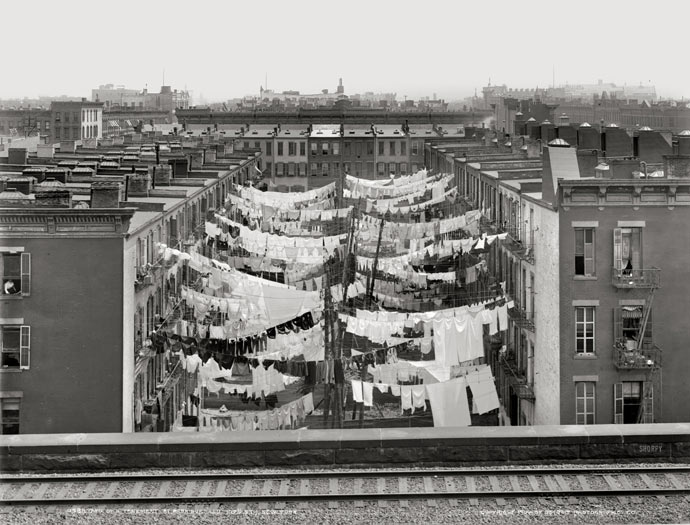
Obviously, this picture was taken on a Monday. The scene is the tenement backyard at Park Avenue and 107th Street in New York, probably in the year 1900.
Setting up these clotheslines was not a trivial task, especially on the higher floors. A man would come around calling out "I climb poles!" and for about 25 cents he'd climb up and run the rope out over the pulleys. He also sold rope and pulleys, but if you'd planned ahead and bought them from the hardware store, you could save a few cents.
Notice the train track at the bottom of the photo--I'm guessing the whites were whiter at the far end of the block. Just on the other side of the tracks is the building where baseball player Lou Gehrig grew up, a few years after this picture was taken.
I suggest viewing this image as large as possible, so you can peep into the windows.
New York
vintage
cityscape
tenement
laundry
(Image credit: Detroit Publishing Co., via Shorpy)
Feb 17, 2010
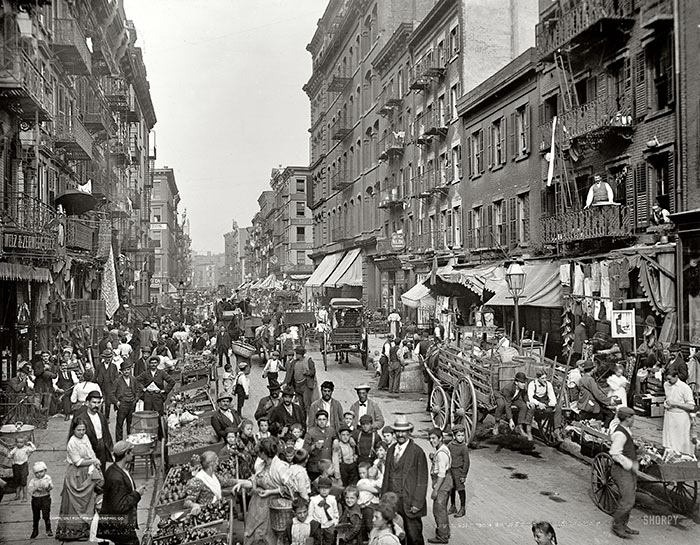
In 1900, Mulberry Street in lower Manhattan was the heart of Little Italy, where life was apparently lived out in the open, right in the street. Nowadays, cars instead of people dominate the street, and the people have retreated indoors, where apartments are much less crowded and much more likely to have indoor plumbing.
Click on this picture to see a much larger version, which you can mouse around in to appreciate the details of life in New York a century ago: the vegetable carts, the guy with a glass of beer in the middle of the street, the boy with his schoolbooks, the Banca Malzone, the aprons and wagons and fire escapes and . . .
New York
vintage
Manhattan
streetscape
Little Italy
(Image credit: Detroit Publishing Co., via Shorpy)
Mar 17, 2010

Last week, the Gowanus Canal in Brooklyn was named a Superfund site, meaning that umpteen million dollars will be poured into cleaning up its pollution. Gowanus water has been sludged with grease and foul-smelling nastiness for a long, long time--so long, in fact, that hardly any new buildings have been constructed in the neighborhood since the nineteenth century.
This painting was recently submitted to the New York Times by an anonymous artist, in response to a call for works remembering the canal and its neighborhood. In this scene, the neighborhood looks bright and vibrant. "The artist's eye can find something special in this unlikely place," noted one New Yorker. "But if you've been there, you know it by the smell."
"And the noise!" observed another. "Lots of old Italian men screaming words of torment and threat into the night, muttering something about busting someone’s head off with a baseball bat."
"This reminds me of the old joke," said a third. "Guy asks, 'What's the quickest way to the Gowanus?' The answer is: 'Borrow five hundred dollars from Dominic and don't pay him back.'"
New York
cityscape
birdseye view
Gowanus Canal
Brooklyn
superfund
Mar 18, 2010

Unlike yesterday's picture, which was also an artist's imagining of the neighborhood surrounding the Gowanus Canal superfund site in Brooklyn, today's picture just lays it out: this may not be such a great place to live. You can't even see the canal itself here--it's just beyond the dead end of the street--but you can almost smell it.
This photo, we might say, is much more realistic, or at least is truer to the ugliness associated with Gowanus that dominates the way the place is commonly experienced. One artist somehow found bright color and lively activity there; today's photographer captured the drab unpleasantness we expect to feel near the nation's newest superfund site.
Tomorrow we'll look at the work of artists who combine both impressions, sort of. It's a complicated canal.
New York
streetscape
Gowanus Canal
Brooklyn
superfund
(Image credit: Kevin Lapp)
Mar 19, 2010

Toxic waste can give a body of water that certain something--a sheen, a glow. Call it art. Perhaps it's not surprising, in light of what a mess we're making of this world, that there has emerged in contemporary art a movement obsessed with discovering beauty in garbage and pollution and rusting husks littering the landscape. It has been argued that the nightmarish provenance of this beauty somehow deepens it, makes it more meaningful.
When one of my children was in elementary school, his teacher assigned a paragraph about something beautiful that they'd seen with their own eyes. My child wrote about the colors shimmering in a little puddle of gasoline in the Crown Station parking lot. The teacher was very upset; she apparently thought he was mocking her and her assignment. Really, he was just showing preternatural aesthetic sensibilities.
New York
art
Gowanus Canal
Brooklyn
water pollution
(Image credit: Josh Verleun)
May 28, 2010
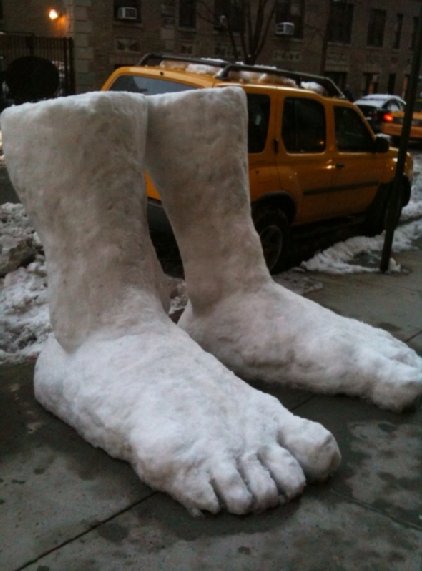
Sculptor Gerry Lynas prefers working in sand, but last February in New York he had no choice but to make do with snow. His "Two Feet of Snow" on W. 83rd Street in Manhattan was actually five and a half feet tall. It lasted only a day and a night; the next morning, one of the legs was in the gutter, perhaps from non-natural causes.
Lynas liked the consistency of that February 10 snowfall; he said he hadn't seen such nice, sticky sculpting snow in New York since 1977, when he built a thirty-foot wooly mammoth in Central Park.
Here's to a Memorial Day weekend of seasonably lousy snow.
New York
streetscape
winter
sculpture
snow
Gerry Lynas
(Thanks to Anna Singer)
Dec 18, 2010
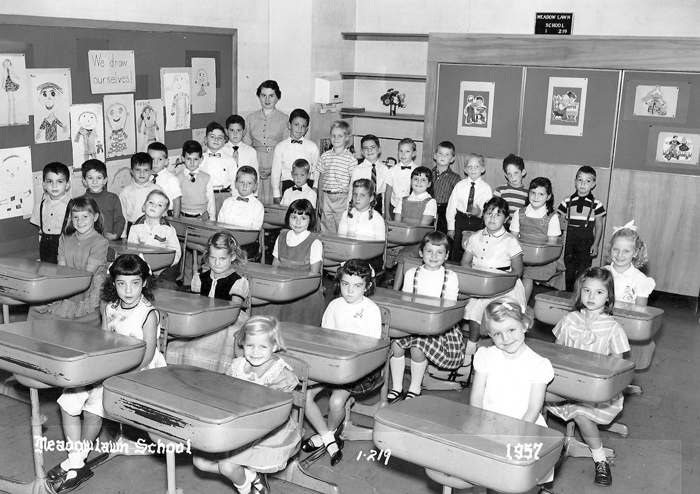
This first grade class in East Meadow, on Long Island, New York, had 32 students in 1957, which was probably a typical class size. Schools just couldn't be built fast enough in the 1950s to hold all us baby boomers coming of (school) age in thousands of new GI subdivisions springing up around cities all over America.
The boy standing second from left, wearing a turtleneck, is Norman.
New York
Long Island
school
Norman
Meadow Lawn Elementary School
Feb 8, 2011

This lucky duck, preening for the camera amongst the ripples of Rockefeller State Park in Pleasantville, New York, was selected for immortality of a sort--or if not immortality, then fifteen minutes of fame, give or take--when Karen and Stuart Berlowitz happened by last fall while out for a walk in the woods. Of all the ducks on all the ponds all over this crazy world, this guy is the one to be get its very own Good Morning post on the intertubes.
New York
fall
animals
ducks
Rockefeller State Park
Pleasantville
(Image credit: Karen Berlowitz)
Apr 23, 2011
 At the Buffalo Zoo, in the new rainforest exhibit, the Wiggin kids find the baby chicks.
At the Buffalo Zoo, in the new rainforest exhibit, the Wiggin kids find the baby chicks.
New York
Joshua Wiggin
Emily Wiggin
children
Buffalo
baby animals
zoo
rainforest
Aug 17, 2011
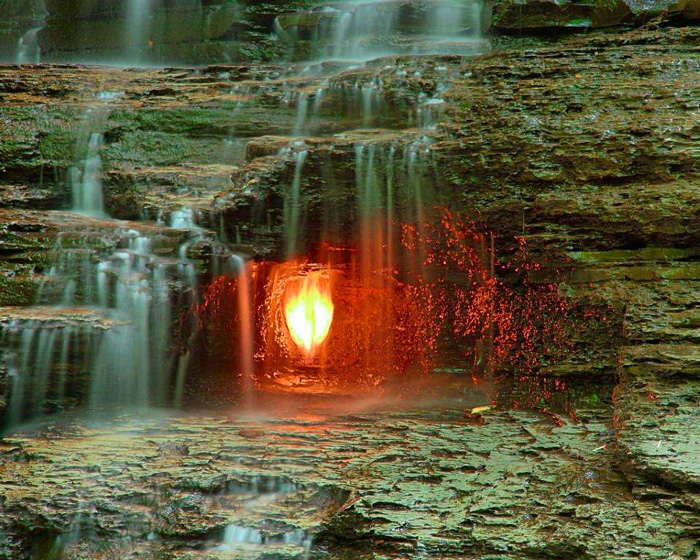 History has not recorded the name of the first person to light a fire in the little grotto behind the waterfall in Shale Creek gorge, now part of Chestnut Ridge Park recreation area in Erie County, New York, near Buffalo.
History has not recorded the name of the first person to light a fire in the little grotto behind the waterfall in Shale Creek gorge, now part of Chestnut Ridge Park recreation area in Erie County, New York, near Buffalo.
Despite the name of the place–Eternal Flame Falls–neither the flame nor the waterflow is perennial. Shale Creek is an intermittent stream, drying up to a trickle except during snowmelt and days of very heavy rain. The methane gas that fuels the flame is always present–it is produced by rotting vegetation trapped in the shale, and it bubbles up through fissures at several places along the creek, notably into a natural alcove large enough to keep the flame dry behind the watery curtain of the falls. But the flame does go out sometimes, if the wind is gusty or the waterflow especially drenching.
The greenish-gray rocks here are part of a formation called Hanover Shale, roughly 380 million years old. Where this shale is at or near the surface, as here, any gas it contains will simply ooze out into the atmosphere, making it economically worthless; in places where the Hanover Shale is buried deep underneath other rocks, however, its gas is trapped under great pressure and may be worth drilling for.
New York
methane
Erie County
waterfall
gas
Shale Creek
Chestnut Ridge Park
(Image credit: Carl Crumley)
Oct 4, 2011
 A tour guide from the Tenement Museum points out features of the neighborhood surrounding the Forward Building at 175 Broadway in New York's Lower East Side.
A tour guide from the Tenement Museum points out features of the neighborhood surrounding the Forward Building at 175 Broadway in New York's Lower East Side.
The Daily Forward was founded at the turn of the twentieth century as a Yiddish-language newspaper for new immigrants from Eastern Europe who were then crowding into the Lower East Side and similar neighborhoods in other American cities. Forward readers were mostly poor people struggling to get a foothold in a new, strange land; the newspaper was active politically as well as editorially in the labor union movement and on behalf of an American Socialist party, and it also promoted cultural Americanization, particularly with respect to Old World Jewish religiosity, which the editors rejected in favor of a more secular and open-minded cultural identity. Among the writers: Isaac Bashevis Singer and Leon Trotsky.
I remember seeing my grandparents reading The Forward on the front porch of their rowhouse in Baltimore in the 1950s. Yiddish was all Greek to me, but I distinctly recall how amusing it seemed that a newspaper called Forward was printed backward.
The irony doesn't stop there, however. The Forward Building in this photo, built by the Socialist publishers in 1917 when circulation exceeded a quarter of a million, was converted to condominiums in the 1990s; I've been told that units in the building start at more than $2 million. The Lower East Side of Manhattan is still a landing place for new immigrants–note the signs in Chinese on the two buildings at the right edge of the picture–but gentrification now attracts rich people to the neighborhood as well. There may still be sweatshops here, but the pushcarts are definitely gone.
The Forward survives today, though just barely, in weekly English and Yiddish editions, each with a circulation of a few thousand.
New York
streetscape
Lower East Side
immigration
Forward
condominiums
Yiddish
Nov 9, 2011
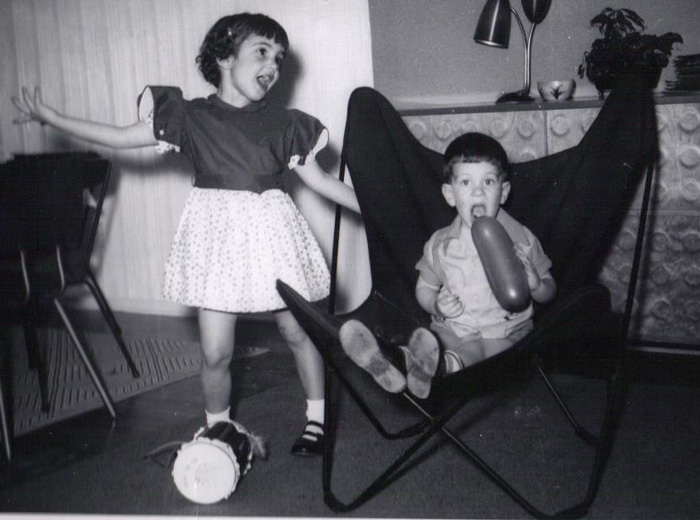 Somehow, Norman believes he can remember sitting in that chair and putting that balloon to his mouth, while Iris Quigley posed for the camera. The photo was probably taken in 1954, maybe 1955, in Iris's house, which was down the street from Norman's house in East Meadow, Long Island, New York. Great furniture, great dance moves, and we can hope those little baby teeth weren't too sharp.
Somehow, Norman believes he can remember sitting in that chair and putting that balloon to his mouth, while Iris Quigley posed for the camera. The photo was probably taken in 1954, maybe 1955, in Iris's house, which was down the street from Norman's house in East Meadow, Long Island, New York. Great furniture, great dance moves, and we can hope those little baby teeth weren't too sharp.
New York
vintage
Long Island
children
1950s
Norman
Iris
East Meadow
(h/t: Iris Quigley)
Dec 20, 2011
 This general store in Fort Covington, New York, a border town about 75 miles southwest of Montreal, was the pride and joy of Elsie and Charles J. Clarke, who are pictured here behind the counter in the mid-1920s. Charles Clarke, who had emigrated to Canada as a boy aboard one of the orphan ships from Liverpool, England, had somehow managed to save up enough money to buy his very own store. A few years later, however, during the devastation of the Great Depression, the Clarkes extended so much credit to their customers and had to conduct so much of their trade by barter that they lost the store.
This general store in Fort Covington, New York, a border town about 75 miles southwest of Montreal, was the pride and joy of Elsie and Charles J. Clarke, who are pictured here behind the counter in the mid-1920s. Charles Clarke, who had emigrated to Canada as a boy aboard one of the orphan ships from Liverpool, England, had somehow managed to save up enough money to buy his very own store. A few years later, however, during the devastation of the Great Depression, the Clarkes extended so much credit to their customers and had to conduct so much of their trade by barter that they lost the store.
New York
store
(h/t: Shorpy)
Elsie and Charles J. Clarke
Fort Covington
1920s
orphan ship
Sep 22, 2013
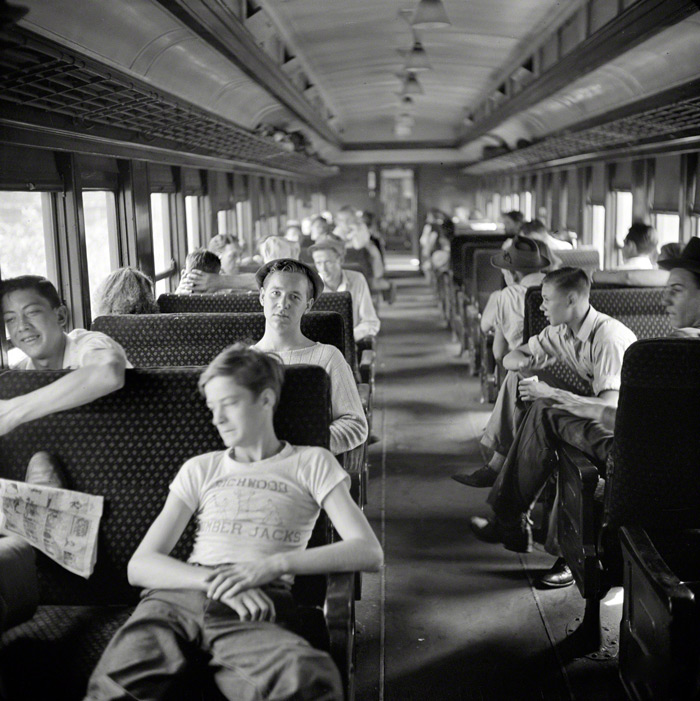 By the summer of 1942, the American war effort was in such high gear that many agricultural regions were experiencing a severe labor shortage. All the young men were serving in the military, almost everybody else was working in war industries, and nobody was left to pick the nation's peas and beans.
By the summer of 1942, the American war effort was in such high gear that many agricultural regions were experiencing a severe labor shortage. All the young men were serving in the military, almost everybody else was working in war industries, and nobody was left to pick the nation's peas and beans.
As part of a program designated "Food for Victory," this specially chartered train brought more than three hundred high school boys and girls from the coal-mining town of Richwood, West Virginia, to the farming district around Batavia in upstate New York, where they would pick peaches, apples, tomatoes, and other crops. The program also brought in teenagers from other non-farming places, including Brooklyn, New York, where one of the high schoolers who signed on to help with the harvest upstate was the young Helen Ruskin, Norman's mother.
New York
West Virginia
Helen
train
World War II
high school
1942
youth
Richwood
(Image credit: John Collier via Shorpy)
Aug 21, 2012
 Philadelphia is standing in for New York City this summer during the filming of Paranoia, a thriller starring Harrison Ford and Liam Hemsworth and directed by Robert Luketic (Legally Blonde).
Philadelphia is standing in for New York City this summer during the filming of Paranoia, a thriller starring Harrison Ford and Liam Hemsworth and directed by Robert Luketic (Legally Blonde).
For example: here in Center City Philadelphia, on 16th Street near Locust, is a New York City taxicab, in a line of cars all bearing New York plates. Look closely, and perhaps you can make out the cars' back-up lights all lit up; this line of traffic was in fact moving in reverse, preparing for the filmmakers to take one more take.
A few weeks ago, this same outfit took over the Rittenhouse Square restaurant Twenty Manning for a day of shooting. Our own Joe Stein, who worked there, was told to take the day off but then called in early the next day to help clean up the mess that Hollywood had left behind.
Some of the people in this photo are extras who were supposed to be walking in or around this intersection as the scene was shot and reshot. Others of the people seen here are Philadelphians who just happened by, and who were supposed to be shooed out of camera range. I couldn't tell the two types of people apart, but the bossy folks wearing orange vests seemed very certain who was who. Somebody yelled at me and my mother to get out of the picture, and insulting as that seemed, we left without putting up an argument.
New York
streetscape
Philadelphia
downtown
movie
vehicles
Sep 24, 2012


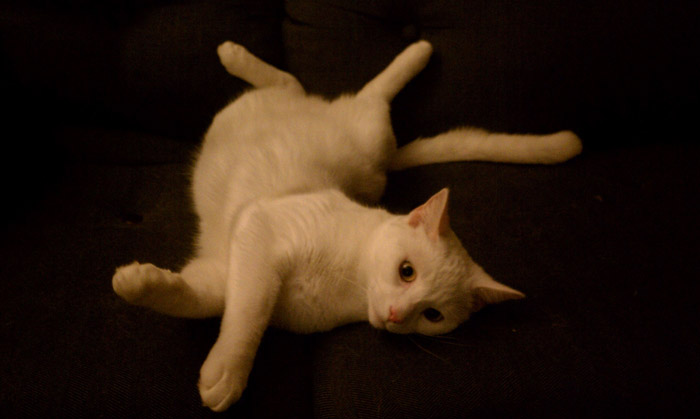 Maggie Stein and Colin Doody write from Rochester, New York:
Maggie Stein and Colin Doody write from Rochester, New York:
We have two cats: Mac and Jasper. Mac is this tall, slim, elegant, handsome, smart and funny young man. However, as he has a shiny black coat, he is fairly difficult to photograph. You can see his eyeballs in the top picture above. That's one of his favorite hiding places: behind all of his favorite DVDs. He's got a comprehensive collection ranging from boy meets world and full house to sleepless in Seattle to black hawk down.
Jasper is our chubby, off-white, special little boy. While he is super cuddly and floppy (as you can see in the two pictures above), he is also less adept at normal cat functions. He often gets stuck up on top of our shelving unit, and he struggles with bathing, using the litter box, and controlling his caloric intake. He might also have a thyroid problem (which, as it turns out is a huge problem due to Rochester's soil), as he likes to sleep at least 18 hours a day. One of his favorite pasttimes, when he's not sleeping of course, includes pulling Q-tips and sponges out of drawers. He also enjoys occupying public areas in protest. While he doesn't voice his opposition well, we think he may have something against Ikea (see photo below).
We hope that our special boys make the Good Morning email. They would be so proud of themselves. Mac might even link to it on his Facebook account. Those interested might consider friending Macbot J. Catson.... he could use a few more friends. (Please don't tell him we said that.)
New York
animals
pets
cats
Rochester
(Image credits: Maggie Stein)
Oct 4, 2012
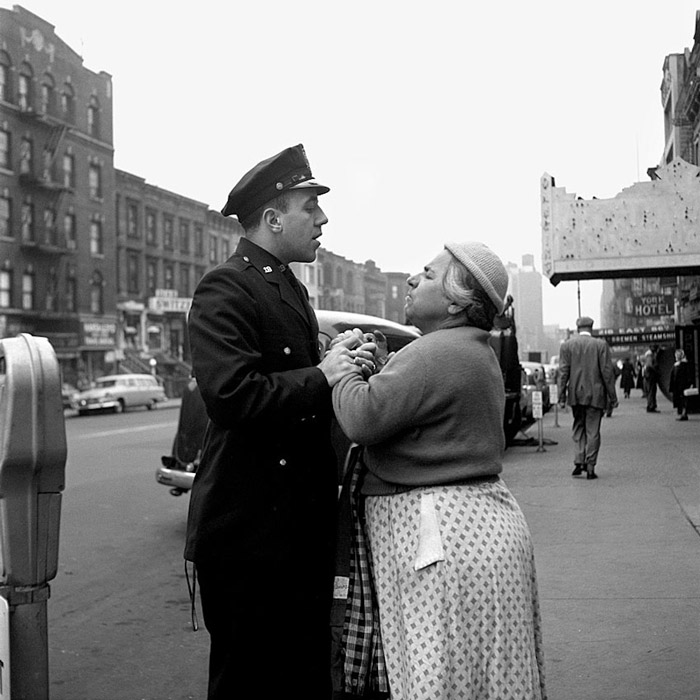 It's now been about two years since Vivian Maier's photographic oeuvre was discovered among the contents of a storage locker that was auctioned off in Chicago. Hundreds of the pictures have now been published in a book and shown in galleries in New York and Chicago. Dozens are posted on a website, VivianMaier.com. She is the subject of a documentary film project. Hundreds of rolls of film she shot have yet to be developed, and perhaps a hundred thousand of her negatives have yet to be printed.
It's now been about two years since Vivian Maier's photographic oeuvre was discovered among the contents of a storage locker that was auctioned off in Chicago. Hundreds of the pictures have now been published in a book and shown in galleries in New York and Chicago. Dozens are posted on a website, VivianMaier.com. She is the subject of a documentary film project. Hundreds of rolls of film she shot have yet to be developed, and perhaps a hundred thousand of her negatives have yet to be printed.
For fifty years, Maier worked as a nanny, first in New York and then in Chicago. Whenever she got a day off, she took her camera out on the street and shot pictures of the people she encountered. She spent all her earnings on cameras and film, and occasionally on travel to places she wanted to photograph. She became technically skillful, with a sophisticated eye for composition and drama. But she never showed her photographs to anyone.
In her later years, she fell on very hard times and became homeless. Shortly before her death in 2011, she was rescued by three Chicagoans who'd grown up under her care; by then, however, her financial struggles had forced her to sell off one of four storage lockers containing her life's work. The purchaser of the locker was a real estate developer named John Maloof, who'd thought he was buying old snapshots of his neighborhood. When he began to realize what he'd stumbled across, he set aside his regular work and devoted all his time to trying to track down the photographer.
Maier, born in 1926, was still alive in 2010 when Maloof began his search but had died before he could find her. We can't know what she would have thought of the whole world now having a look at the pictures she kept secret for so long. But at least we can look.
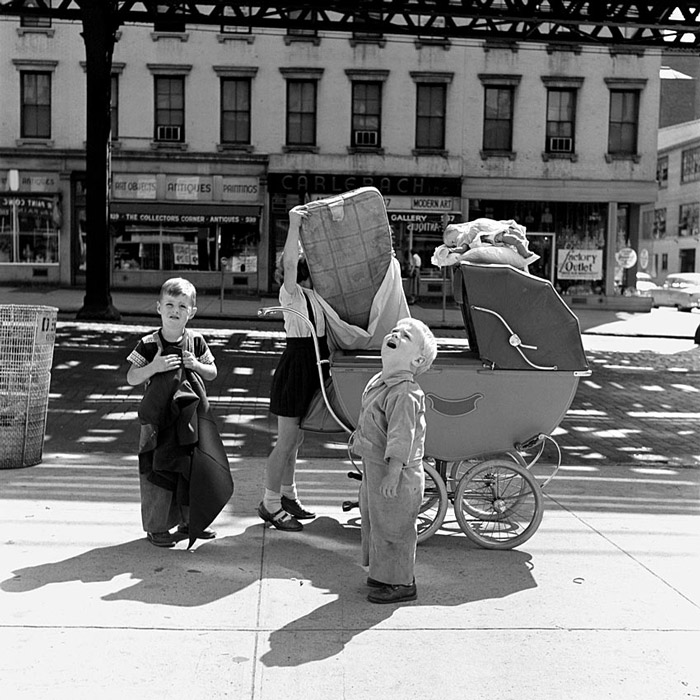

New York
Chicago
1950s
photography
portraits
streetscapes
(Image credits: Vivian Maier
Jan 25, 2013
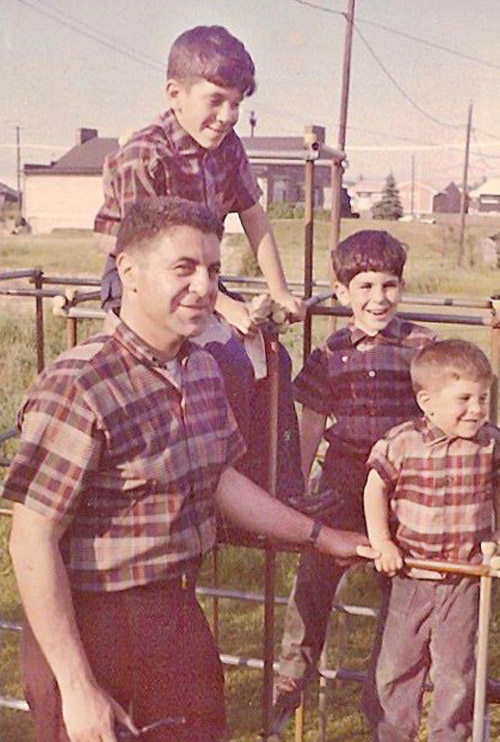
Dressed in madras and all over that jungle gym in East Meadow, New York, probably circa 1959–Joe Stein with his boys: Normy, Richie, and Bobby.
New York
Long Island
family
Joseph Stein
East Meadow
Norman, Richard, Bob Stein
jungle gym
1959
Mar 9, 2013
 Nice looking skyline, is it not? The city is Albany, New York, which may or may not be a nice place to live or even a nice place to visit; I've never been there and yet . . . here I am squawking about it.
Nice looking skyline, is it not? The city is Albany, New York, which may or may not be a nice place to live or even a nice place to visit; I've never been there and yet . . . here I am squawking about it.
It's actually one of the oldest continuously inhabited cities in the Western Hemisphere, founded in the early seventeenth century as Beverwijk, a Dutch village outside the gates of Fort Orange. Beverwijk was renamed Albany when the English took over in the mid-century, and in 1686, the city was officially incorporated under a charter that is said to be one of America's oldest governing documents still in effect.
Albany was also the eastern terminus of the Erie Canal and for many years produced beer that was shipped westward on the canal to all the thirsty pioneers out in the hinterlands.
The painting below shows Albany's North Pearl Street in approximately 1800.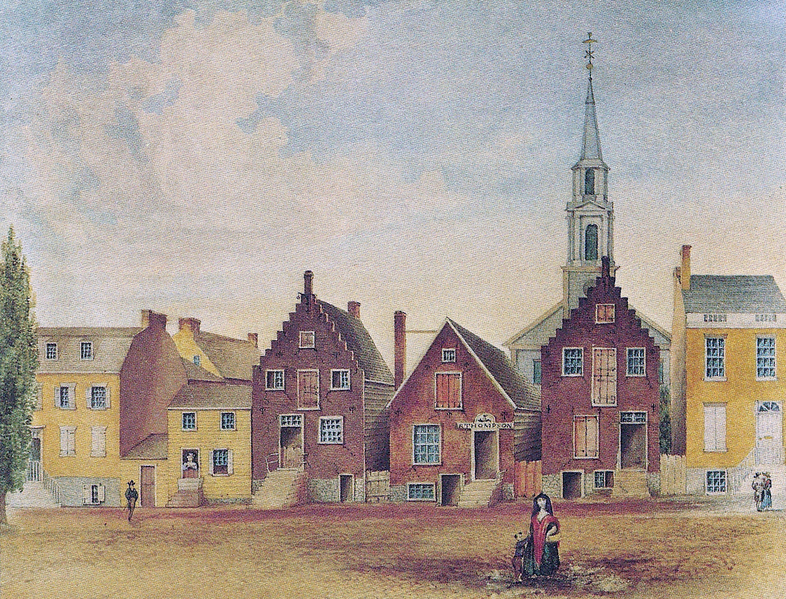
New York
cityscape
art
streetscape
skyline
Albany
1800
(Photo h/t skyscrapercity.com; Artwork by James Eights)
Jul 27, 2013
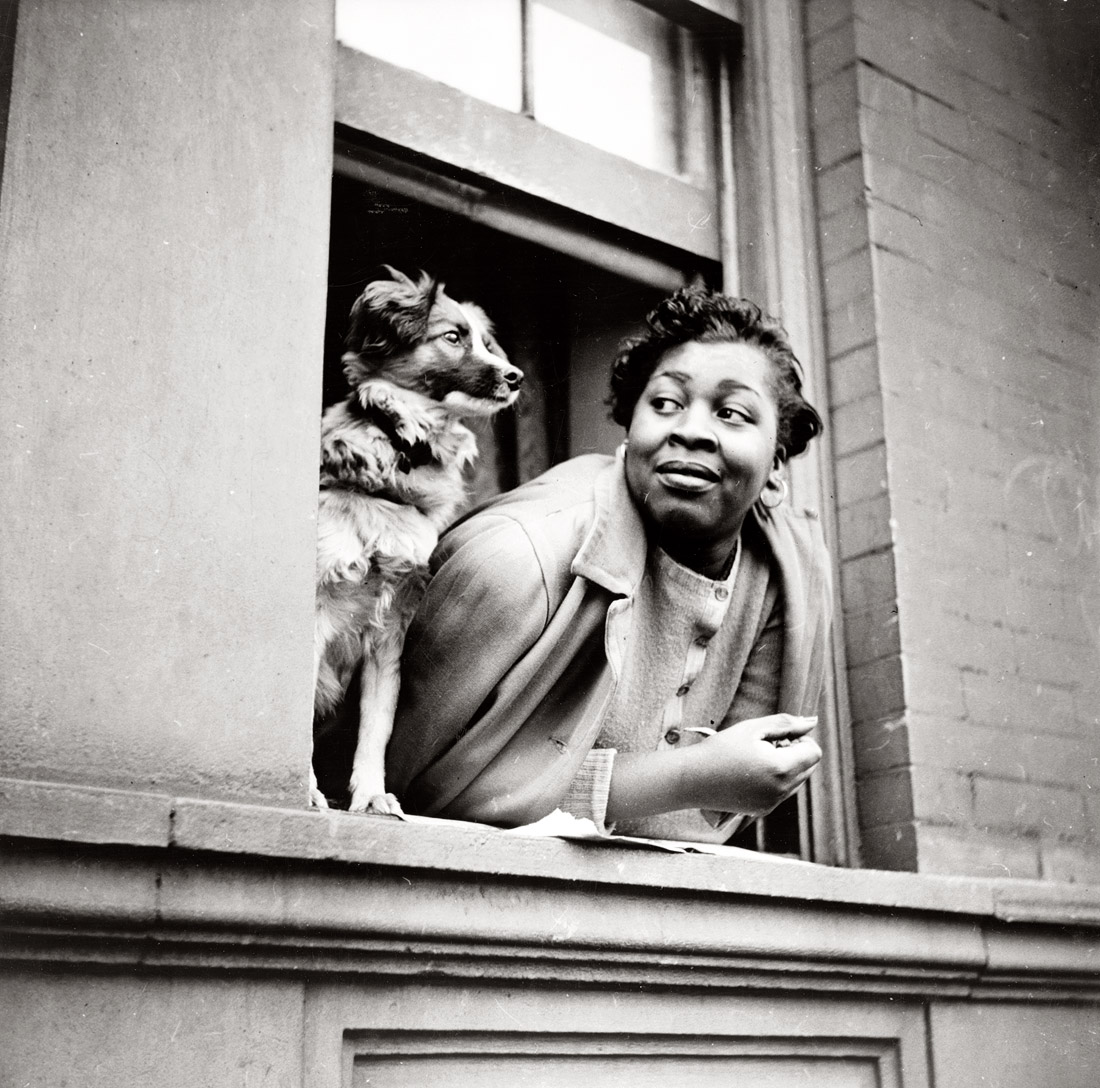 A woman and her dog, by Gordon Parks. New York, May 1943.
A woman and her dog, by Gordon Parks. New York, May 1943.
New York
dog
streetscape
portrait
window
Harlem
(Image credit: Gordon Parks via Shorpy)
Nov 11, 2013
 Veterans' Day is Armistice Day, except that it's not. Calendar-wise, they're the same, but pausing or parading to show gratitude for our veterans is not really the same as pausing to commemorate the moment 95 years ago when soldiers lay down their weapons and those among them who still had the vitality and the nerve climbed out of their trenches and tried to put World War I behind them.
Veterans' Day is Armistice Day, except that it's not. Calendar-wise, they're the same, but pausing or parading to show gratitude for our veterans is not really the same as pausing to commemorate the moment 95 years ago when soldiers lay down their weapons and those among them who still had the vitality and the nerve climbed out of their trenches and tried to put World War I behind them.
We know more than a few military men and women who squirm at hearing "Thank you for your service," which servicepeople hear all the time these days. All too often, what the people who say it really mean by it is: "Hey, I'm not one of those dirty hippies who burned their draft cards and stuff during Vietnam–I'm a real American, and here's my business card." Or something like that.
Still. We are grateful for our veterans and for all the people through the years who put their lives on the line for us. People sacrificed so much in so many wars, and way too many of those who benefited from their sacrifice are obnoxious Americans like me.
Anyways, VJ Day, much like Armistice Day, was a very good day for hundreds of millions of people around the world. We young folk know it mostly from Eistanstadt's iconic photo of a kiss in Times Square, recreated here in Lego by photographer Mike Stimpson.
New York
World War II
World War I
Vietnam
Alfred Eisenstadt
military
Lego
Times Square
Veterans Day
(Image credit: Mike Stimpson via mikestimpson.com)
Dec 27, 2013
 We open this post with a small step back in time, to October of this year, when our niece Melissa Koehler married Matt Solomon. We noted this elegant and awesome occasion at the time but somehow managed to omit any photo of the bridegroom. By now, photographers and videographers and Facebook contributors have documented the day in images worth a billion skillion words, and from all that treasure we selected a frame from a video, with its swirl of wind and an imminent kiss.
We open this post with a small step back in time, to October of this year, when our niece Melissa Koehler married Matt Solomon. We noted this elegant and awesome occasion at the time but somehow managed to omit any photo of the bridegroom. By now, photographers and videographers and Facebook contributors have documented the day in images worth a billion skillion words, and from all that treasure we selected a frame from a video, with its swirl of wind and an imminent kiss.
Below are pictures of four other of our nieces, two sets of sisters, taken as they celebrated with Melissa that day. At left are Maggie and Amelia; to the right are Avi and Gillian. These pictures are tightly cropped to feature the nieces; people have been cropped out literally and perhaps also figuratively as we try to keep the focus on these young women.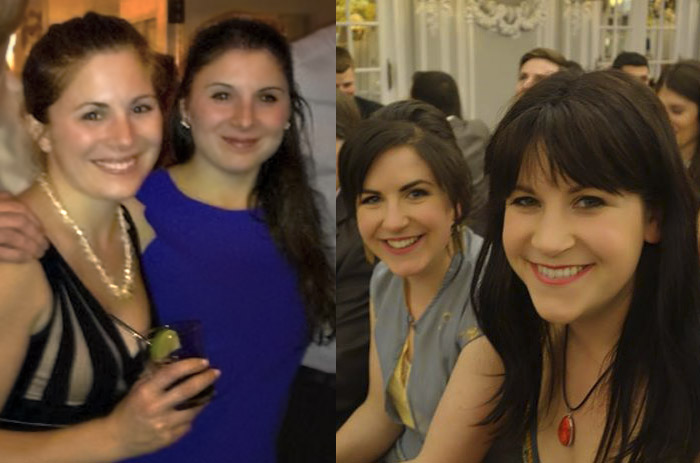
Gillian's wedding, of course, was just this month in New Zealand. Maggie's was back in June in Maine. Gillian works in Wellington, New Zealand, organizing ecotourism adventures. Maggie is a nurse in Rochester, New York, studying to become a nurse practitioner.
Maggie's little sister, Amelia, wearing blue in the picture, lives and works in New York City, where she is creative director for a brand new startup fashion label, The Girl That Loves. Amelia prepares marketing materials and designs the company's overall look and feel.
Who is The Girl That Loves? According to the website, she's a girl who's "going places, but she plans to have a good time getting there."
She mixes edgy and trendy pieces with cute and playful pieces. Her favorite combo? Sexy heels, jeans and a sweatshirt (and possibly a fedora). Tadaaaa! Looking great has never been so comfy! Instead of breaking her bank over one designer piece she lines her closet with a variety of fun pieces. She likes simple, elegant clothing but enjoys taking an occasional risk: the right neckline, a bit of cool embroidery or an edgy color scheme can turn a piece from “like” to “love.”
Here is one of The Girl That Loves' new designs, in the playful category, a rhinestone panda skirt that perhaps, when some people wear it, can go from "like" to "love" in a heartbeat.
At the other end of the world from New York City, on New Zealand's South Island, Amelia's cousin Avi is herself no slouch when it comes to fashion; in fact, she once was almost turned down for a job because an interviewer thought she dressed much too nicely for someone in her line of work. Avi earns her living by studying penguins in their natural habitats.
She's just beginning a new position at Oamaru Blue Penguin Colony, on the east coast of New Zealand about three hours' drive south of Christchurch. There at the edge of town, hundreds of little blue penguins, the world's smallest penguin species, sometimes called fairy penguins, have colonized an abandoned limestone quarry, making their nests at the top of a steep rocky slope just outside Oamaru's harbor.
Most days, the penguins leave the colony before dawn to swim several miles to their fishing grounds offshore; they fish all day and then return home at nightfall. Their nightly return has become something of a tourist attraction in Oamaru, so much so that an important research focus for scientists like Avi is how best to manage interaction between the public and the penguins.
Below is a huddle of Oamaru penguins just back from the sea; they swam in together as a "raft" and then paused amidst the rocks, perhaps just to catch their breaths and cool off after their long swim. Penguins' greasy feathers keep them very warm, so warm that to prevent overheating they have to fluff themselves, as they've done here, to allow chilly evening air to reach their skin.
Little blue penguins are not endangered, but many local populations are at risk because of land predators such as dogs and cats, which are not native to New Zealand. In the water, they are preyed upon by fur seals. In some coastal areas, they get hit by cars while trying to cross the road at dusk.
At the bottom of this post is a portrait of a little blue guy. He weighs about four pounds or less and is only 12 inches tall, not even knee high to a ten year old.

New York
New Zealand
fashion
Melissa
Amelia
Maggie
Avi
Gillian
penguins
Oamaru
The Girl That Loves
Nov 6, 2014
 Two cranes get their act together high in the sky above New York City's High Line promenade.
Two cranes get their act together high in the sky above New York City's High Line promenade.
Many, many cranes are hard at work these days in that neck of the woods; apparently, real estate developers are firmly of the opinion that people will pay even more than the usual Manhattan rates to live in an apartment or condo near the High Line. They may be right; nobody's yet found the ceiling on what New Yorkers will pay for anything.
New York
Manhattan
cityscape
cranes
skyline
skyscrapers
High Line
(Image credit: Fuji T)
Jan 27, 2015
 In 1899, snow was shoveled off busy Manhattan streets, loaded into wagons, and hauled down to the docks, where it was dumped in the river.
In 1899, snow was shoveled off busy Manhattan streets, loaded into wagons, and hauled down to the docks, where it was dumped in the river.
Nowadays, the EPA doesn't like for states or municipalities to dump dirty snow from city streets into rivers or, as in the case of Portland, Maine, into the ocean. Portland used to throw its snow from downtown into the harbor, but it now builds mountains of snow, dump-truckload after dump-truckload, in an empty field near the airport.
New York City trucks its snow to melting machines, known as snow dragons, which can melt thirty tons of snow an hour and discharge the meltwater into the city sewer sytem. In an emergency, however, such as a ridiculously huge blizzard, we are told that the EPA will look the other way while the city rids its streets of snow the old-timey way.
New York
streetscape
winter
snow
horses
work
1899
wagons
(Image credit: Detroit Publishing Co via Shorpy)
Feb 21, 2015
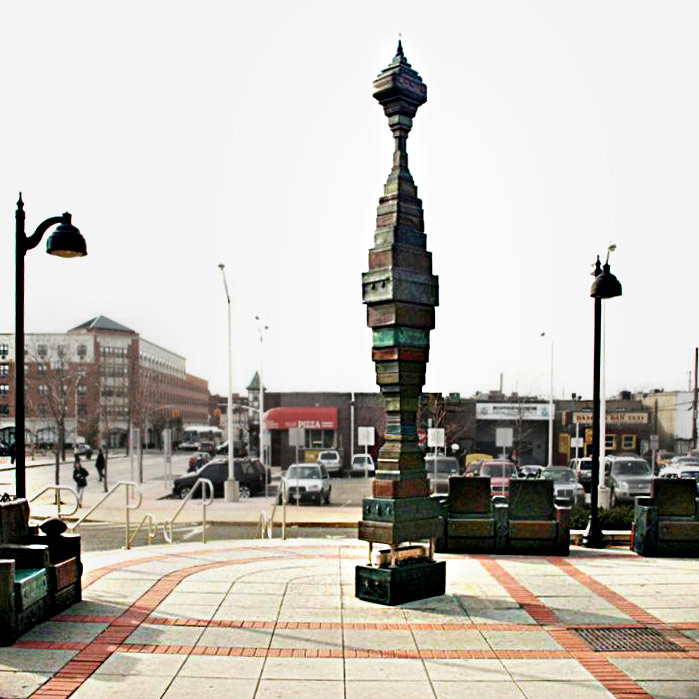 Ron Baron's "Lost and Found," bronze luggage and seating, was installed in 2010 in a plaza outside a new Long Island Railroad station in Hempstead, New York.
Ron Baron's "Lost and Found," bronze luggage and seating, was installed in 2010 in a plaza outside a new Long Island Railroad station in Hempstead, New York.
New York
art
sculpture
bronze
Ron Baron
plaza
Long Island Railroad
Hempstead
(h/t: Chris Williams)
Apr 20, 2015
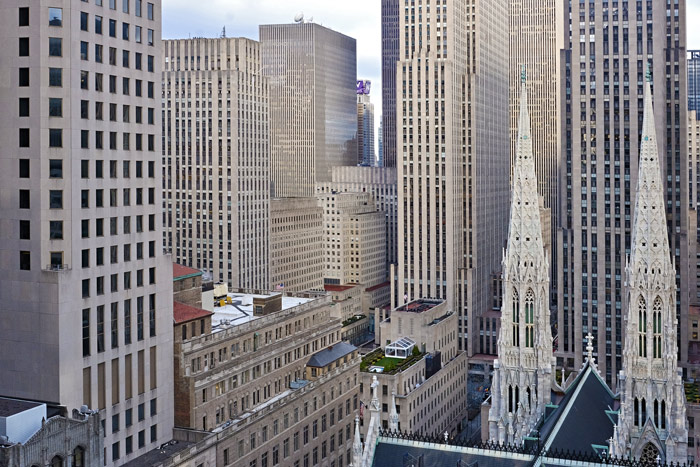 St. Patrick's Cathedral from behind and a little bit above, in midtown Manhattan. We enjoyed this view from the window of our hotel room during a recent trip to New York.
St. Patrick's Cathedral from behind and a little bit above, in midtown Manhattan. We enjoyed this view from the window of our hotel room during a recent trip to New York.
New York
Manhattan
skyline
skyscrapers
rooftops
St. Patrick's Cathedral
midtown
spires
(Image credit: Fuji T)
Apr 24, 2015
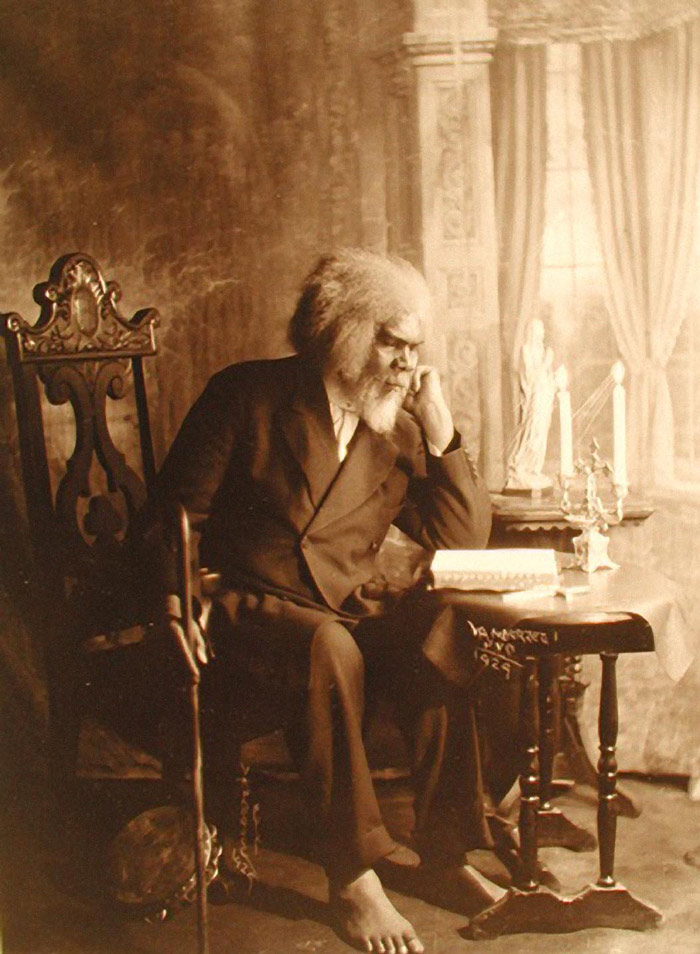 In this photograph, taken in 1929, the visions of two men come together.
In this photograph, taken in 1929, the visions of two men come together.
The subject of the portrait is Clayhorn Martin, a Harlem street preacher who had gone barefoot ever since the day in his youth when God told him to shed his shoes and walk on holy ground. Till the day he died, he walked the streets with his tambourine, shouting to the world that God dwells in every single person, not in church buildings or special dignitaries.
Martin was a homeless man, a neighborhood character. In this formal studio portrait, photographer James Van Der Zee focused not so much on his outward condition as on his internal seriousness and faith. In other words, the scene he set for his camera aimed to take Preacher Martin at his word, seeking to show the higher purpose within him.
Martin had been born a slave in Virginia in 1851; he died homeless on the street in 1937. Van Der Zee and other artists of the Harlem Renaissance raised money to give him a proper sendoff, a funeral attended by five hundred or more of his neighbors, his flock.
New York
portrait
Harlem
Elder Clayhorn Martin
homeless
1929
studio portrait
street preacher
(Image credit: James Van Der Zee)
Feb 8, 2016
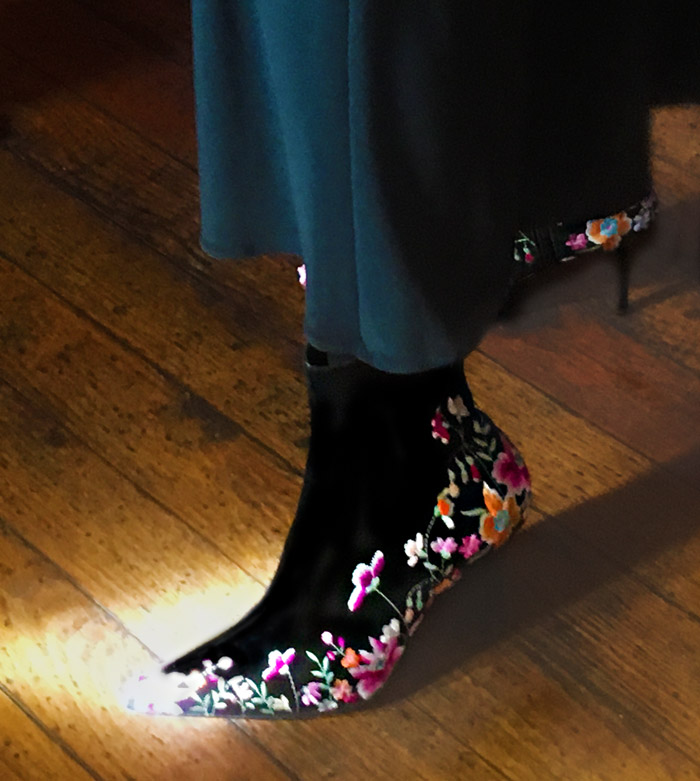 Cousin Michele was rocking her shoes Saturday at her retirement party.
Cousin Michele was rocking her shoes Saturday at her retirement party.
The party playlist featured an Alice Cooper number that kinda set the tone, as Michele celebrated completion of approximately forty-eleven years as a schoolteacher in Brooklyn and Queens. School's out now, at her house.
New York
Michele Manno
party
shoes
retirement
Mar 23, 2018

Soon.
New York
winter
snow
spring
Baldwin
(Image credit: Michele Manno)




































 Veterans' Day is Armistice Day, except that it's not. Calendar-wise, they're the same, but pausing or parading to show gratitude for our veterans is not really the same as pausing to commemorate the moment 95 years ago when soldiers lay down their weapons and those among them who still had the vitality and the nerve climbed out of their trenches and tried to put World War I behind them.
Veterans' Day is Armistice Day, except that it's not. Calendar-wise, they're the same, but pausing or parading to show gratitude for our veterans is not really the same as pausing to commemorate the moment 95 years ago when soldiers lay down their weapons and those among them who still had the vitality and the nerve climbed out of their trenches and tried to put World War I behind them.






 Ron Baron's "Lost and Found," bronze luggage and seating, was installed in 2010 in a plaza outside a new Long Island Railroad station in Hempstead, New York.
Ron Baron's "Lost and Found," bronze luggage and seating, was installed in 2010 in a plaza outside a new Long Island Railroad station in Hempstead, New York.


